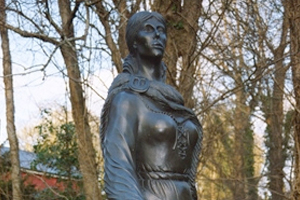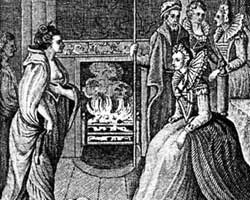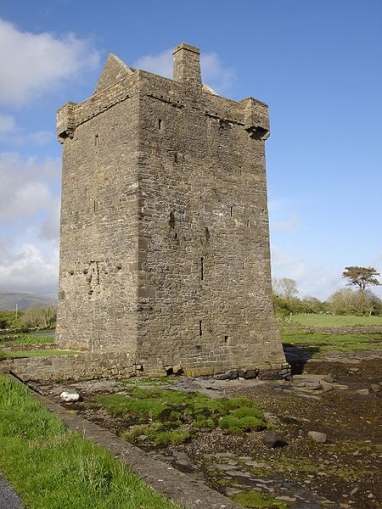Gráinne Ní Mháille: Gaelic "Sea Queen of Connacht" who refused to bow to the English Queen
Grace O'Malley (c. 1530 – c. 1603; Irish: Gráinne Ní Mháille) was chieftain of the Ó Máille clan in the west of Ireland. The only child of Owen Dubhdara Uí Máille, the O’Malley of Umhall Uachtarach, and Margaret Ní Máille. She was commonly known as Gráinne Mhaol (anglicised as Granuaile). A proud and courageous woman, she is a well-known historical figure in 16th-century Irish history. Sometimes known as "The Sea Queen of Connacht" or even “The Pirate Queen” after she inherited her father’s significant shipping and trading business, which was sometimes described as a form of piracy. Gráinne saw her wealth grow from this business, along with land inherited from her mother, and property and holdings from her first husband, Dónal an Chogaidh Ó Flaithbheartaigh. However, she lived in very turbulent times and witnessed the collapse of the Gaelic order and the crushing of Ireland’s ruling élite. It brought her face to face with Queen Elizabeth I of England in 1593, a meeting at which Gráinne refused to bow, stating that she herself was a Queen of her land and not a subject of the Queen of England.
Gráinne (Grace O'Malley) lived during a time of crucial importance in Irish history. When Gaelic society was under continued attack and the existing order was being destroyed. Henry VIII (28 June 1491 – 28 January 1547) was the first English monarch to proclaim himself King of Ireland. Before that English monarchs styled themselves as "Lord of Ireland" during a period of feudal rule in Ireland between 1177 and 1542 and used this title to refer to their position in areas of conquered lands on the Island of Ireland. In reality, the English king's rule only ever extended to parts of Ireland. Many areas remained separate and outside English rule until the 16th century. The title "Lord of Ireland" was changed by the Crown of Ireland Act passed by the Irish Parliament in 1542 under the command of Henry VIII when he was granted a new title, King of Ireland, with the state renamed the Kingdom of Ireland. During this period there was an attempt to centralise power and to Anglicise the population. After Elizabeth I (7 September 1533 – 24 March 1603) came to power this process of destroying Gaelic Ireland increased, given added impetus by her commitment to the Reformation. English settlement, plantation and the imposition of crown officials was reaching further into the old Gaelic established order. All of this led to violence, resentment and upheaval. By 1607, Ireland was fully under English control, bringing the old Gaelic political and social order to an end.
Gráinne lived through this period when she required all her determination and strength to oppose the forces arraigned against her. As England steadily gained control of Ireland, she was placed under increasing pressure to relent to the English crown. Following the capture of her two sons Tibbot Burke and Murrough O'Flaherty, and her half-brother, Dónal na Píopa by the English governor of Connaught, Sir Richard Bingham, Gráinne sailed to England and had a direct meeting with Queen Elizabeth I at Greenwich to petition for their release. On meeting the Queen, Gráinne refused to bow, stating that she herself was a Queen of her land and not a subject of the Queen of England. The meeting was conducted in Latin as Gráinne spoke no English and Elizabeth did not speak Irish. Initially agreement was reached with a number of stipulations upon each party and the return of Gráinne’s two sons. This even included Elizabeth agreeing to remove Sir Bingham from his position in Ireland. However, Elizabeth soon sent Bingham back to Ireland and this, along with other of Gráinne’s demands having failed to be met, led her to the conclusion that meeting with Elizabeth had not met her expectations. Gráinne threw her support behind the forces of the Irish Gaelic Chieftains during their fight against English rule during the Nine Years' War (1593 to 1603).
It is thought that Gráinne died at her stronghold of Rockfleet Castle around 1603. Years after her death her ability as a leader was an inspiration to the Irish people. Many folk stories, songs and poems recall the life and time of Gráinne Ní Mháille (Grace O’Malley). For her meeting with Queen Elizabeth I was only one of her many legendary exploits. She is remembered and admired as a courageous woman. One of a long line of Gaelic rulers of Umaill a kingdom that is located in the west of what is now County Mayo, Ireland. Gráinne Ní Máille lived in difficult times, but used all of her skill and determination to maintain the status of her family at a time when the Gaelic order in Ireland was being destroyed and English encroachment was reaching into all parts of Ireland.








